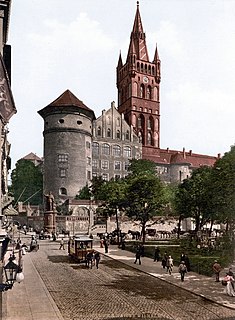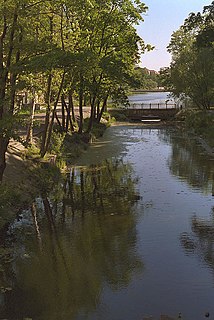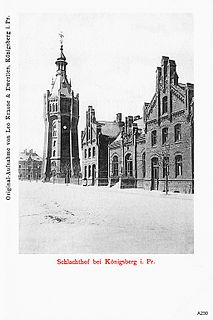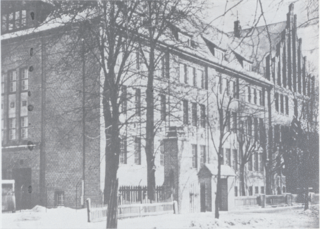Rothenstein was first a suburb of and then a quarter of northeastern Königsberg, Germany. Its territory is now part of the Leningradsky District of Kaliningrad, Russia.
A quarter is a section of an urban settlement.

Königsberg is the name for a former German city that is now Kaliningrad, Russia. Originally a Sambian or Old Prussian city, it later belonged to the State of the Teutonic Order, the Duchy of Prussia, the Kingdom of Prussia, the German Empire, the Weimar Republic and Nazi Germany until 1945. After being largely destroyed in World War II by Allied bombing and Soviet forces and annexed by the Soviet Union thereafter, the city was renamed Kaliningrad. Few traces of the former Königsberg remain today.

Germany, officially the Federal Republic of Germany, is a country in Central and Western Europe, lying between the Baltic and North Seas to the north, and the Alps to the south. It borders Denmark to the north, Poland and the Czech Republic to the east, Austria and Switzerland to the south, France to the southwest, and Luxembourg, Belgium and the Netherlands to the west.
Rothenstein was located northeast of the Oberteich. It was connected to Maraunenhof by the road Cranzer Allee and to Kummerau by Rothensteiner Straße.

The Upper Pond is a large artificial pond in northern Kaliningrad, Russia. It was known as the Oberteich while part of Königsberg, Germany, until 1945.
Maraunenhof was a suburban quarter of northern Königsberg, Germany. Its territory is now part of the Leningradsky District of Kaliningrad, Russia.
A retirement and nursing home opened in Rothenstein in 1914. A munitions explosion at Rothenstein's munitions factory caused the death of 200 workers on 10 April 1920; Friedrich Lahrs and Stanislaus Cauer designed a memorial in the nearby Gemeindefriedhof cemetery to honor the victims. The architect Kurt Frick developed the housing development Siedlung Rothenstein after his return to Königsberg in 1921. Rothenstein was incorporated into the city of Königsberg by 1927.
Johann Ludwig Friedrich Lahrs was a German architect and professor.
After the Soviet capture of Königsberg during World War II, the NKVD established an internment camp in Rothenstein. Michael Wieck was among the incarcerated.

The Soviet Union, officially the Union of Soviet Socialist Republics (USSR), was a socialist state in Eurasia that existed from 30 December 1922 to 26 December 1991. Nominally a union of multiple national Soviet republics, its government and economy were highly centralized. The country was a one-party state, governed by the Communist Party with Moscow as its capital in its largest republic, the Russian Soviet Federative Socialist Republic. Other major urban centres were Leningrad, Kiev, Minsk, Alma-Ata, and Novosibirsk.

World War II, also known as the Second World War, was a global war that lasted from 1939 to 1945. The vast majority of the world's countries—including all the great powers—eventually formed two opposing military alliances: the Allies and the Axis. A state of total war emerged, directly involving more than 100 million people from over 30 countries. The major participants threw their entire economic, industrial, and scientific capabilities behind the war effort, blurring the distinction between civilian and military resources. World War II was the deadliest conflict in human history, marked by 50 to 85 million fatalities, most of whom were civilians in the Soviet Union and China. It included massacres, the genocide of the Holocaust, strategic bombing, premeditated death from starvation and disease, and the only use of nuclear weapons in war.
The People's Commissariat for Internal Affairs, abbreviated NKVD, was the interior ministry of the Soviet Union.






